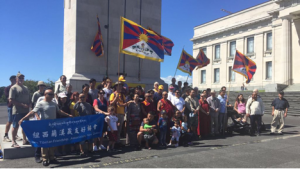Events were held across the globe this weekend, showing solidarity and support for the Tibetan people on their 59th Tibetan National Uprising Day

Tibetans in Dharamshala on March 10
Photo: tibettimes
To commemorate the 59th anniversary of the March 10 Tibetan National Uprising Day, the five Tibetan non-government organisations (NGO) in Dharamshala — The Tibetan Youth Congress(TYC), Tibetan Women Association, Gu-Chu-Sum movement, National Democratic Party of Tibet and Students for Free Tibet — held a joint press conference entitled 59 years of Tibetan resistance. The event was held on March 2, followed by four days of collaborative events. The NGOs requested that China’s President XI Jinping stop intensifying the repression of Tibetans, and described the March 10, 1959 and 2008 uprisings as two of the most powerful examples of resistance in Tibetan history.
On that day in 1959, 300,000 Tibetans took to the streets of Tibet’s capital, Lhasa, surrounding His Holiness’ palace and forming a human sea of protection for their leader. The Chinese had invaded, outnumbering Tibetan fighters 25 to two, and they feared for the Dalai Lama’s life. On March 15, an escape route for His Holiness was planned, guarded by Khampa rebels (Khampas are the residents of the Kham region of Tibet) and His Holiness’ bodyguard. An estimated 50,000 Chinese troops armed with heavy artillery surrounded Lhasa. Two days later, the city came under fire. His Holiness finally decided he had to leave his homeland. Fighting raged for two days with the odds stacked against the Tibetan resistance. Thousands of men, women and children were slaughtered.

CTA’s official function at temple, Dharamshala
Photo: tibet.net
This event, along with numerous other Tibetan uprisings, is commemorated every year. In Mcleod Ganj, Sikyong Lobsang Sangay – President of the Tibetan Government-in-Exile – called for unity among Tibetan people in front of hundreds of supporters at the Dalai Lama’s temple. Following the official ceremony, the crowd of Tibetans and supporters hoisted the Tibetan national flag and took part in a peaceful procession from the temple to the police ground in lower Dharamshala, all the while shouting for a free Tibet.
The Tibetan Gu-Chu-Sum movement, meanwhile, organised a photography exhibition to commemorate the 30th anniversary of the 1988 uprising in Lhasa. Images were displayed at the martyrs pillar near the main gate of His Holiness’s temple, acknowledging the courage and sacrifices made by the Tibetan martyrs and to show solidarity with the Tibetan political prisoners who remain in Chinese prisons.
In Delhi, on the eve of the National Uprising Day the Tibetan Youth Congress led a peaceful protest near the Chinese embassy. The police detained about 80 protesters, among whom were the organisation’s Social Service Secretary Tashi Thargyal, and former political prisoner Ven Bhagdro.
The protests were by no means restricted to Indian soil. Tibetans from all over the world took to streets to commemorate the occasion. In Nepal, where for years Tibetans have been banned from protesting due to the government’s closer relations with China, took to the streets anyway. They were soon stopped by the Nepali police, but not before making their voices heard.
In Europe, Tibetans in Geneva marked the day with slogans demanding freedom and human rights in Tibet, while in London, United Kingdom, a protest took place at the Chinese Embassy, supporters gathering with banners and flags and singing the Tibetan national anthem. Twenty parliamentarians of Latvia, Lithuania and Estonia also issued statements of support for Tibet.

Tibetans and supporters in Australia on March 10
Photo: tibet.net
Others in Asian countries including Taiwan and Japan mourned and prayed for the Tibetan people who have been imprisoned and killed since the 1959 invasion. About 300 supporters gathered at Bele Oblaka Centre in Moscow for a prayer service, while similar services were also held in South Africa and Australia.

Tibetans and supporters in New Zealand on March 10
Photo: tibet.net
The Chinese government staged a display of strength, showcasing a large drill in Lhasa and other major towns and cities throughout Tibet. China’s rule has been characterised by tight surveillance and human rights abuses, and Chinese clampdowns are now the norm in Tibet, particularly during this politically sensitive period. In Kumbum the military stormed a prayer session and scanning machines were installed at the entrance to the monastery. China has increased its 2018 defence budget by over 8%, amounting to $175bn (£126bn). The reasoning behind it: “to firmly and resolvedly safeguard national sovereignty and security”.

Tibetans and supporters in New York
Photo: tibet.net
As these events have shown, however, Tibetans are far from giving up, and they continue to make their voices heard across the globe.




 Print
Print Email
Email